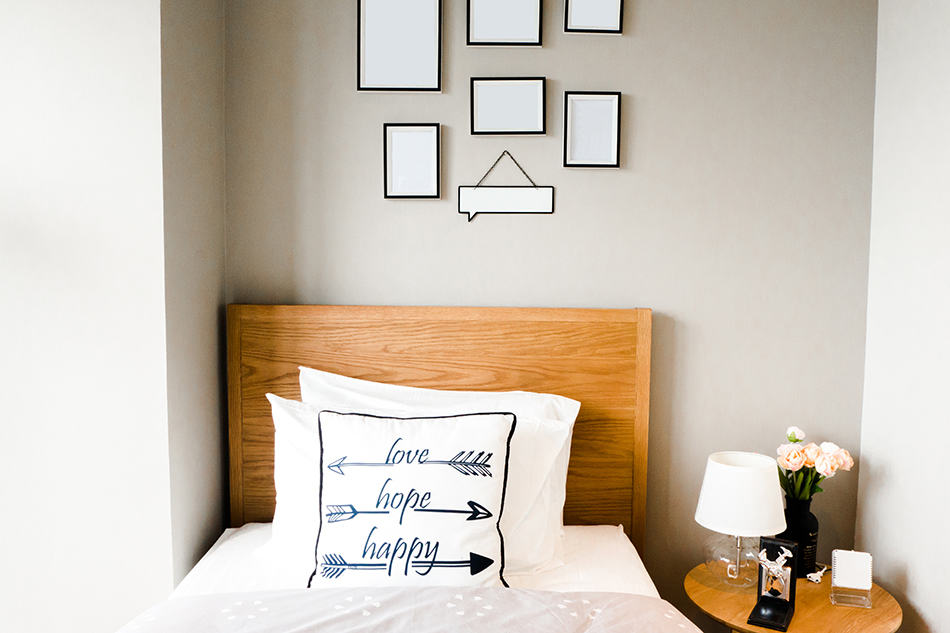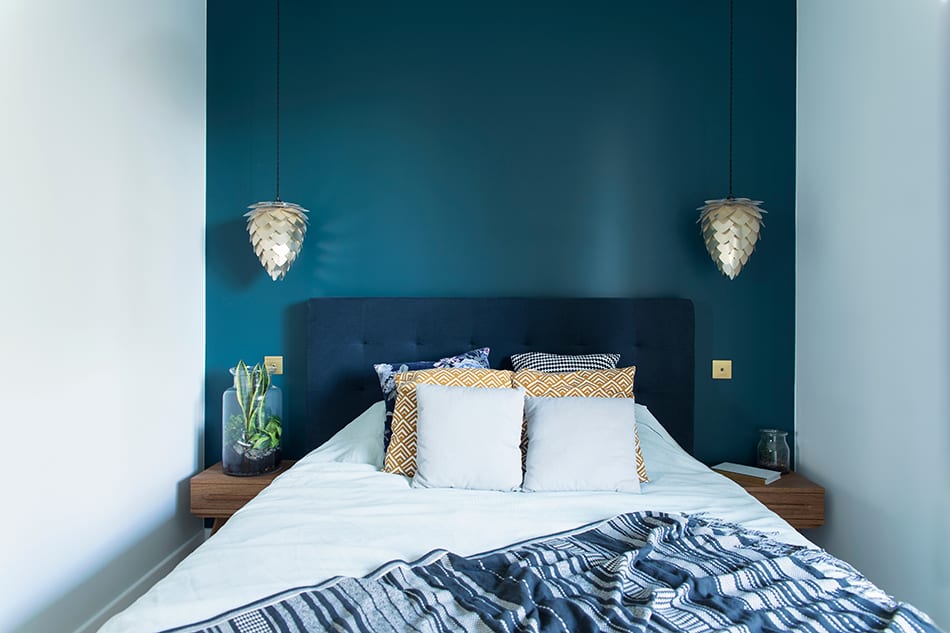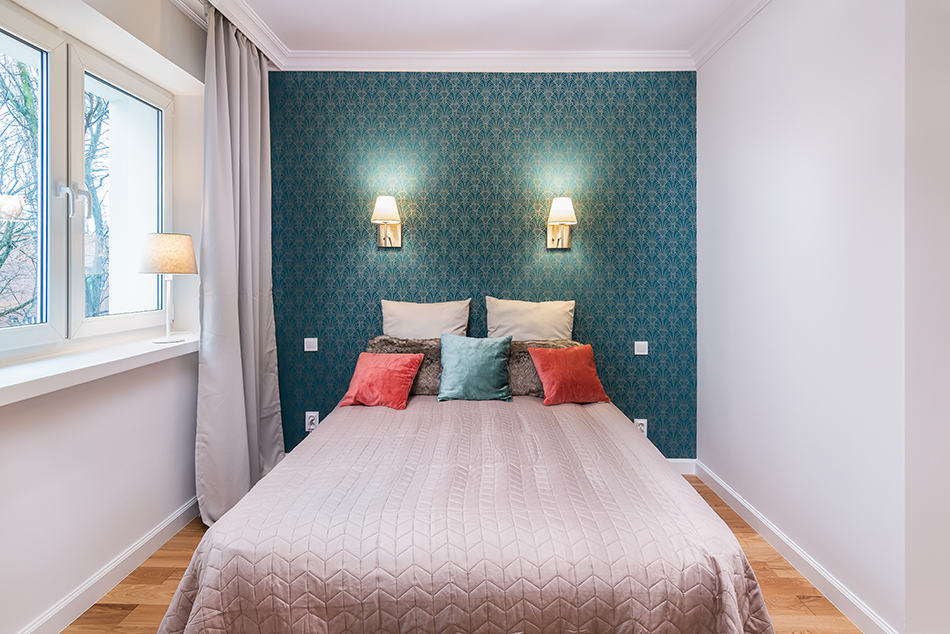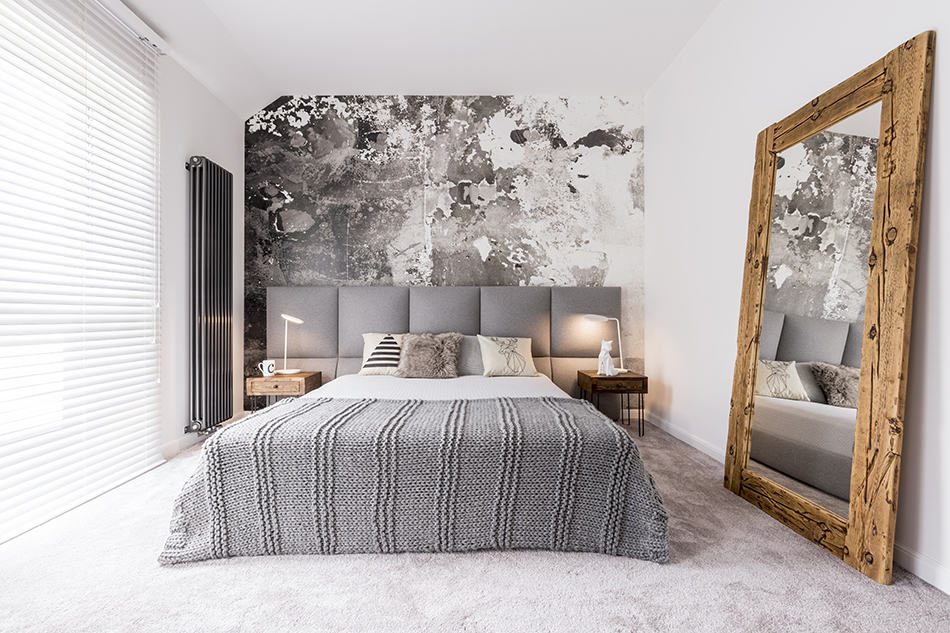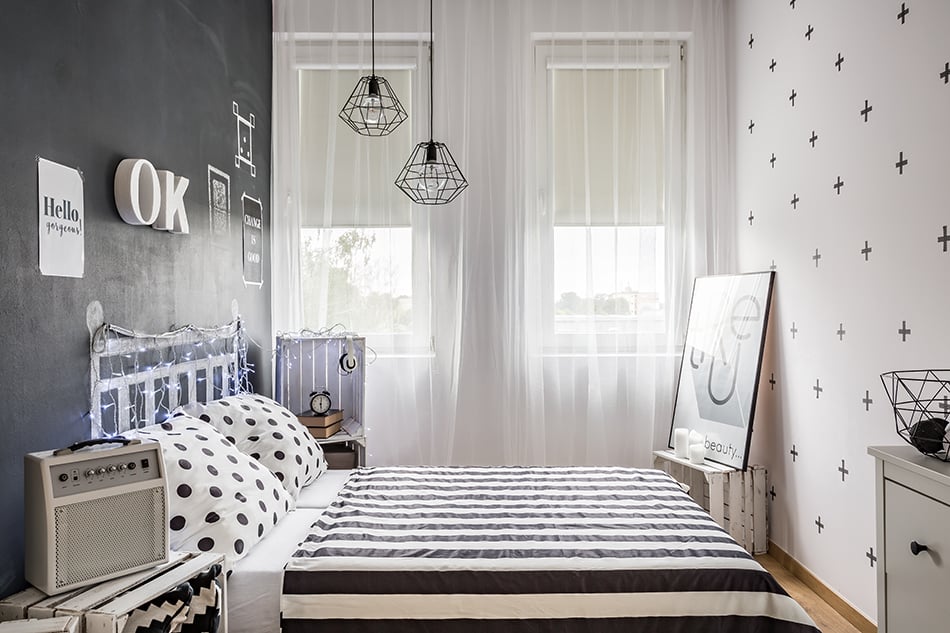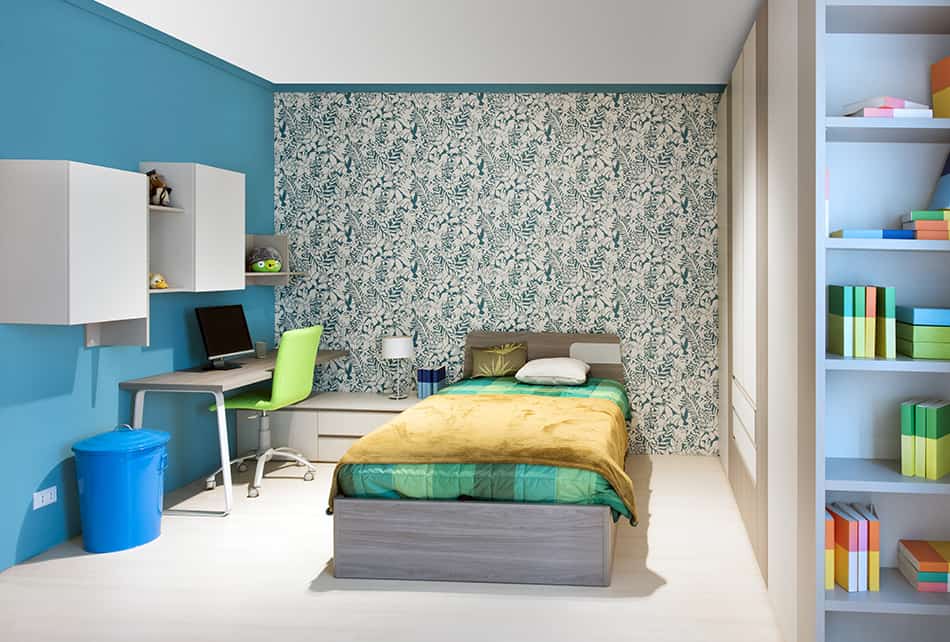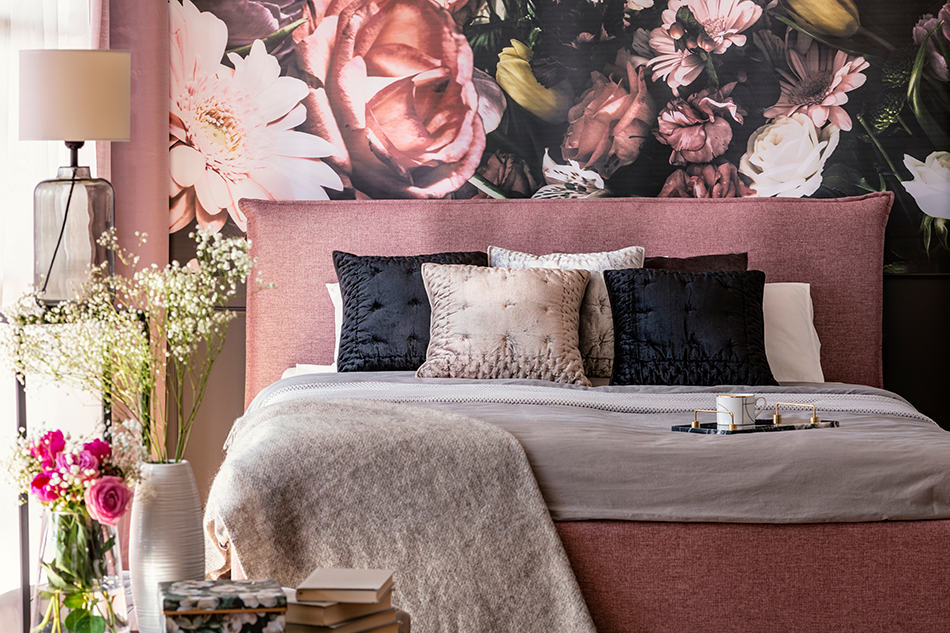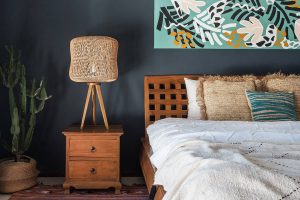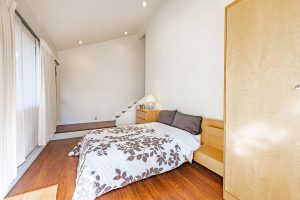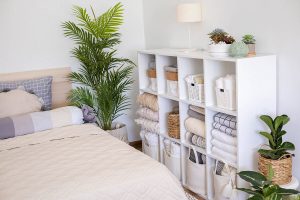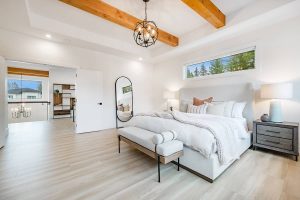Up until recently, accent walls have been reserved for larger rooms, as they were believed to make a small room feel even smaller. The advice for many years has been to paint small bedrooms in light or pale colors in order to create a feeling of more space and avoid dark colors, as these will have the opposite effect.
Pale colors on walls in small rooms reflect light, which helps to create the illusion of more space. Dark colors do the opposite of this and absorb light, which can make a room feel smaller, but this isn’t always the case.
By following some clever rules and making careful decisions, you can design an accent wall for a small bedroom and actually make the room feel bigger.
What Is an Accent Wall?
An accent wall is an interior wall that is decorated differently than the other walls in the room. When most people think of accent walls, they envisage a boldly painted wall or a wallpapered wall, but there are no boundaries when it comes to accent walls, and the sky’s the limit in terms of imagination.
A growing trend for accent walls is fixing wooden planks or old pieces of pallet wood to the wall to cover it, or you can even use hardwood or laminate floorboards attached to the wall for a mountain lodge or natural vibe. Another alternative idea is to tile an accent wall or drape it in fabric for a boudoir effect.
Can Small Bedrooms Have Accent Walls?
The answer to this is an absolute yes. Accent walls in small bedrooms can create the illusion of a bigger space, as well as allow the resident to express their personality through interior decor. An accent wall can be a fairly quick and easy way to upgrade a bedroom on a budget, as you only need to buy materials for updating one wall.
The idea of an accent wall means you can change the whole feel of a bedroom without having to redecorate all of the walls and avoid the cost and inconvenience that comes along with decorating an entire room. It’s also equally easy to cover up an accent wall if you get bored of it.
For small bedrooms, accent walls are best when they use a color that is darker than the remainder of the room. This can be achieved by choosing a dark color of paint or a wallpaper with a dark background or dark accents. Follow these helpful guidelines to ensure you design your accent wall for a small bedroom in a way that enhances the space rather than diminishes it.
Dark Accent Wall in Small Bedroom Tips
Many people shy away from creating a dark accent wall in a small room out of fear that they will make the space appear smaller, but this can be easily avoided.
Choose Cool Color
When selecting a color for an accent wall in a small bedroom, you should lean towards dark shades on the cool side of the color palette. This is because warm colors, such as orange and red, pull the wall into the room and give the impression of less space. Colder colors, like blue and purple, make the wall seem further away and therefore create the illusion of a larger space.
Using a dark color is a good choice for a small room because it balances out the dimensions of the room and blends the edges, which all help the room to feel bigger than it actually is. You can choose a contrasting color for your accent wall or a color that complements the remainder of the walls in the room.
Most small bedrooms are painted in a pale color, so an easy option that always works is to choose a color that is darker but has the same tone. So, for example, if the room is already painted in pale pastel pink, choose a deep pink for the accent wall.
Use Color Swatch
When painting an accent wall, you should always get a tester pot of paint and use it on your chosen wall before committing to painting the whole wall. This is because the way light works in the room will affect how the color looks. The color of the paint will look different at different times of the day due to the position of your room and the placement of your windows in correlation with where the sun rises and sets.
Artificial lighting will also affect the final color of the paint, including the angles at which light hits the wall and the type of lightbulbs you have in the room. To ensure you are completely happy with your paint choice, apply the color to your accent wall and watch how it changes over the course of 24 hours before making your final decision.
Choose Wall Carefully
One of the most important tips to follow is to choose your accent wall carefully. In a small bedroom, you need to pay particular attention to your wall choice, as painting the wrong wall can make the room feel like it is closing in on itself.
If the room is fairly square with walls that are all roughly the same size as each other, then your best choice of the wall will be the focal wall. This is the wall which is behind your bed, the main feature of the room.
Choosing the focal wall in a square room will draw the eye to this point in the room. If the room is narrow, then opt for one of the smallest walls as the accent wall.
Painting the narrow wall as opposed to the long wall will help to balance out the dimensions of the room and make it seem more square than it actually is, creating the illusion of more space.
Introduce Reflective Materials
If you’re worried about an accent wall making a space feel closed in, then you can counteract this with clever placement of reflective materials. An easy way to create the illusion of more space is to place a larger mirror on the accent wall, or you can fix reflective objects onto the wall, such as metal wall art or metal photo frames.
The light reflecting off the metal or mirror will make the bedroom feel bigger.
Contrast with Light Furnishings
It’s good to tie in your accent wall with the rest of the room by matching it up with decorations. For example, incorporating a few dark emerald green cushions in a room with a dark emerald green accent wall will help improve the style and coordination of the decor.
However, when you have a dark accent wall and too many dark furnishings, it can drag the room down, so be sure to keep the majority of the furnishings a light color that will contrast with the accent wall. The contrast between the light and dark helps to divert attention to different areas of the room, which can also help to make it feel bigger.
Wallpaper Accent Wall in Small Bedroom Tips
Using wallpaper to create a feature or accent wall is a popular method of introducing color or pattern into a bedroom.
There are so many beautiful wallpapers out there, and when wallpapering the whole room can seem a little overwhelming, the option of just doing one wall can be appealing. A wallpaper accent wall in a small bedroom can work well as long as you stick to a few simple ideas.
Choose Small Patterns
An accent wall in wallpaper with large patterns will make a small bedroom look even smaller. Instead, choose a small repeating pattern to enhance the room’s space. When it comes to stripes, you can use this pattern to play visual tricks and create the illusion that the room is bigger than it is, so long as you choose.
If your accent wall is narrow, you can use horizontal striped wallpaper to disguise the true size of the wall and give the impression that it is broader. Never use vertical stripes on a narrow wall, as this will elongate the wall even further and make it seem more narrow.
Choose Reflective Textures
Wallpaper with reflective textures, such as shimmering or glittering features, will help to reflect the light and make the room feel bigger. This will work in both dark and light colors, and it will also add a feeling of texture and depth to the room, which creates a feeling of more space.
Avoid Windows and Doors
When designing an accent wall, you should try to avoid choosing a wall that has windows or doorways on it, as this interferes with the flow of the accent wall.
This is even more imperative if using wallpaper as your accent because having to work around windows and doors can make the process of applying the wallpaper very tricky, especially if you are doing it yourself instead of hiring a professional. Choosing a solid expanse of walls works best both practically and in terms of style and space.
